Executive Summary
DoseSystem intends to expand its operations into the US market. The firm has identified the US as an attractive foreign market destination. The firm intends to tap the prevailing market potential by offering a medication solution that will assist patients and caregivers to adhere to medication programs. However, to succeed in the US market, the firm’s designers must develop an adequate understanding of the prevailing market conditions. This report entails an extensive analysis of the macro business environment in the US healthcare industry by integrating different models such as Porter’s five forces, PESTLE analysis, and SWOT analysis. The report further evaluates the attractiveness of the market and the entry modes that the firm should consider in entering the target market.
Introduction
Product designers and developers focus on maximising the level of profitability through aggressive market expansion. In a bid to achieve this goal, the firm’s designers have integrated the concept of internationalisation. Gabrielsson, Gabrielsson, and Seppala (2012) cite internationalisation as one of the critical issues in the success of firms in an industry that has become intensely competitive. Internationalisation increases an organisation’s level of market involvement. Succeeding in the international market requires a business to develop an adequate understanding of the target market. Gaining sufficient understanding of the target market is essential in developing insight on how to utilise the organisational resources to succeed in the international market. This report entails a comprehensive evaluation of the attractiveness of the US as the desired investment destination.
Company Analysis
Company Background
DoseSystems is a medication reminder system that is developed by Danish industrial designer, Studio Jesper K. Thomsen APs and Partners. Some of the partners include the Danish nursing homes and aged care facilities. The motivation to develop the product has arisen from the dedication to resolving medication problems. The effectiveness of the product in resolving the medication needs has largely been improved by extensive user involvement. Two main investors, viz. SDTI and WTI, have supported the product development process financially (DoseSystem 2015).
Product Background
The product offers medication solutions to different healthcare systems. The system helps citizens to be self-reliant in their medication process by reminding them to adhere to their medication programs. Secondly, DoseSystem improves the effectiveness and efficiency of caregivers in executing their duties. The system has significantly improved the citizens’ peace of mind by promoting their ability to monitor medicine consumption. The system is comprised of three main elements, which include the DoseSystem App, DoseCan, and DoseTray. The DoseSystem App is comprised of an overview and alarms that can be easily accessed through tablets and smartphones. According to DoseSystem (2015, par. 2), the DoseCan includes ‘an electronic mini medicine chest for dose packed medicine and pillboxes and it uses beeps and flashes to remind the citizen that it is time to take the medicine’. Conversely, the DoseTray entails a pillbox that has a roller cover for effective handling. DoseSystem can assist citizens to adhere to the medication program of different kinds of medicines.
The product was recently introduced in the Danish market and it has already been sold to 7 Danish municipalities that offer age care services. The product development process has extensively involved different municipalities within the country. Currently, 33 out of the 98 municipalities have shown interest in the product and they will be approached soon. The product’s demand has also extended into the international market. The countries that have shown interest in the product include Taiwan and Norway.
Target Country Profile
The product designers intend to introduce DoseSystem into the US. The choice of the US as an investment destination has arisen from the identification of its attractiveness. A study conducted by DePhillips (2007) indicates the existence of a significant gap regarding the adoption of information technology. The study cites medical errors and care fragmentation as some of the major issues within the industry. It is estimated that over 98,000 people in the US die every year due to medical errors. One of the medical errors contributing to this high death rate entails medication mistakes. Apart from death, the cost of treating preventable drug-related injuries has increased substantially (DePhillips 2007). Therefore, there is a high probability of DoseSystem gaining a high degree of market acceptability. However, to succeed in the US market, the firm’s management team needs to develop an adequate understanding of the prevailing market conditions. In a bid to achieve this goal, the designers should conduct an extensive evaluation of the macro-environment. The external environment has a significant impact on the growth and survival of business organisations (Dragnic 2014). One of the most effective models that businesses can adopt in understanding the market includes the PESTLE model as evaluated herein.
PESTLE Analysis
Political Environment
The US is characterised by a considerably low political risk, which has arisen from a stable democratic political system. Political risk entails the political events that have the capacity of affecting normal business operations adversely. The country is governed by an effective constitution that was effected on 4th March 1789. Over the past few years, the US has been characterised by minimal incidences of civil disturbance, armed conflicts, and capital controls. The graph below illustrates a comparison of the political risk between different countries.
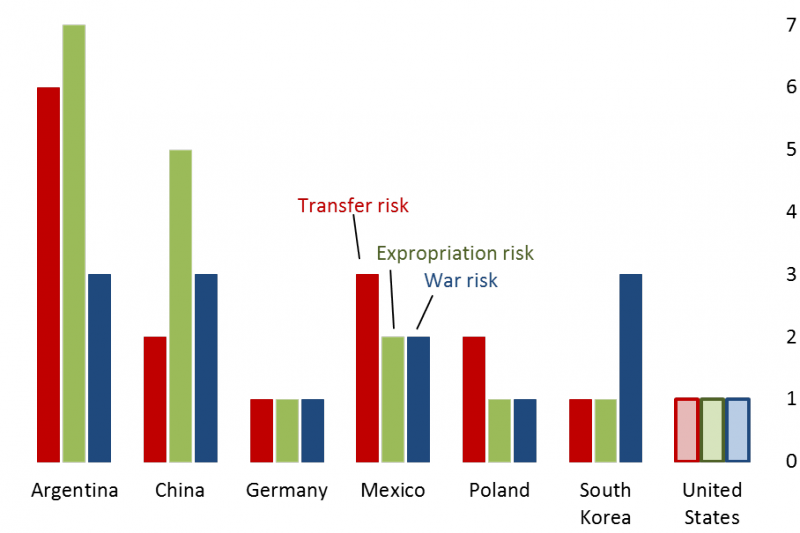
The graph shows that the US has a considerably low degree of political risk. The US attractiveness to foreign investors is further promoted by its preparedness for different disasters. Additionally, the country has a considerably low transfer risk, which refers to the restrictions imposed by governments regarding the movement of funds between countries by private agents. The map below illustrates the transfer risk score across different countries.
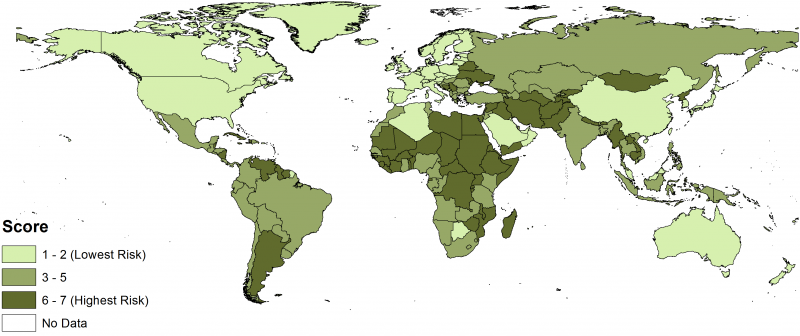
The map above shows that the US has a considerably low degree of transfer risk. The United States Department of Commerce (2015) asserts that political stability in the country has increased the degree of predictability in the business environment. The country has progressively become attractive for business investment. The security risk within the country is substantially low. Thus, investors are assured of the physical safety of their property. Security is a critical issue that investors consider in the process of making foreign investment decisions.
Economic Environment
The US has experienced considerable economic growth over the past decades. The country’s average GDP growth rate between 1947 and 2014 was estimated to be 3.27%. However, economic growth slowed down to -2.1% in 2014.
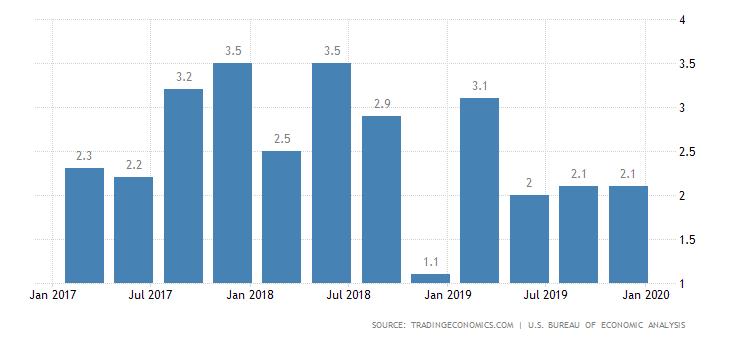
The fluctuation in the country’s economic performance in 2014 was largely due to macro-environmental changes such as the extensive winter seasons. Subsequently, the level of profitability of most organisations has been greatly impacted. However, the country is projected to undergo slow, but steady economic growth shortly (Gordon 2012). In addition to the above economic growth, the country’s economic environment is also characterised by a considerably low rate of inflation. Between 1914 and 2015, the country’s rate of inflation was estimated to be 3.3%. The low rate of inflation has led to an improvement in the consumers’ purchasing power. Additionally, the rate of inflation has led to a stable consumer index. The chart below illustrates the trend in the country’s rate of inflation between 1014 and 2015.
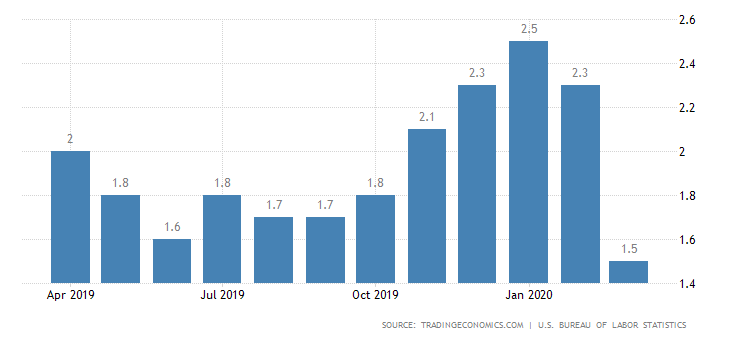
One of the factors that will stimulate the country’s attractiveness to domestic and foreign investors is that it has entered a bilateral trade agreement with different countries. Thus, businesses in the US are in a position to export their products to different countries.
Social-Cultural Environment
A country’s social structure is a critical determinant of the success of a business (David & Boryana 2014). The US is the fourth most populous country in the world. Its total population is estimated to be 318,892,103 citizens. The largest proportion of the country’s population is aged between 25 and 54 years. Furthermore, the total dependency ratio within the country is estimated to be 51%. However, the total dependency within the country is expected to grow due to an increase in chronic diseases.
A study conducted by Vision for Healthier Future (2007) cites chronic diseases as one of the major causes of disability and death in the United States. Approximately, 7 out of 10 deaths in the United States are due to chronic diseases. Over 1.7 million people die every year due to chronic diseases. It is estimated that over 164 million Americans will be suffering from chronic diseases by 2025, which represents 49% of the country’s total population. However, a study conducted by the Vision for Healthier Future (2007) asserts that chronic diseases can be managed by improving the quality of life.
Morgan and Kennedy (2010, p.1) affirm that prescription drugs ‘has become a major component of health systems worldwide’. However, in the US, prescription drugs mainly increase with age. This aspect means that there is a high probability of citizens in the US appreciating the contribution of the DoseSystem in managing the medication processes (Morgan & Kennedy 2010). In addition to the above aspects, the US has been characterised by a considerable change in consumer behaviour. One of the notable changes relates to the consumption of Internet-related products and services.
Technological Environment
Over the past years, the US has undergone considerable growth regarding technology. One of the areas that have grown substantially relates to information communication technology. Investors in different economic sectors are increasingly appreciating the contribution of ICT in their operation process. The motivation towards technological development has been spurred by the need to eliminate medical errors, which has become a major challenge in the industry (Redwood et al. 2011).
Healthcare providers are increasingly considering computerising their service delivery to attain operational efficiency. Moreover, US consumers have incorporated ICT in their consumption process. This trend has arisen from the recognition of technology as a critical aspect of enhancing effective and efficient consumption. Moreover, the US has experienced a significant development regarding infrastructure.
Legal Environment
The US is characterised by the least burdensome legal environment in the world. The cost of complying with business regulations in the US is relatively lower as compared to other countries. For example, businesses can easily access an operating license from the US government. Additionally, foreign companies can easily assess financial credit from the banks in the US (United States Department of Commerce 2015).
According to the latest rating in the on the attractiveness of the legal environment, the US was ranked seventh amongst the 189 economies considered in the study (United States Department of Commerce 2015). However, the US has integrated comprehensive rules and regulations that businesses are required to adhere to in their operations. One of the ways through which the government promotes innovation is by integrating comprehensive intellectual property laws. The intellectual property laws ensure that investors’ research and development efforts are protected from counterfeiters. Patents influence the success of small and medium-sized enterprises. Therefore, DoseSystem designers should consider integrating the concept of patenting in introducing the product into the US market. Through this approach, DoseSystem will entrench adequate protection of the product.
Other Risk Factor Analysis
The operation of the DoseSystem is greatly dependent on the effectiveness of the implemented ICT platform. Currently, the past few years have been characterised by the occurrence of digital-related crime (Dirk & Zhou 2014). Therefore, the effectiveness of DoseSystem in offering medication solutions to clients may be affected by instances of sabotage by criminals and competitors who may employ unfair competition practices. Sabotage on Dosesystem’s operational platform may affect its reliability, hence its usability.
Potential Competitor Analysis
The firm may incur intense competition from other industry players. Some of the firms that might a competitive challenge to DoseSystem include Vitaphone and Evondos Limited.
Evondos Limited
This organisation has developed a unique service solution that can be applied by health care providers at home. The firm’s automatic medication dispensing service assists patients to deal with problems associated with non-adherence to their medication programs. Subsequently, the medication solution significantly improves patient safety. The medication service offered by Evondos Limited has gained significant acceptance by caregivers, private service providers, local authorities, and patients on long-term medication programs (Evondos 2015). Moreover, Evondos Limited offers additional medication solutions through a well-established telecare service. The adoption of these operational strategies has greatly improved the attractiveness of the medication solution to different clients (Ramaseshan, Ishak & Russell 2013, p. 1226).
Vitaphone
The organisation operates as a mobile and telemedicine healthcare provider. The organisation mainly specialise in offering medical providers the ability to diagnose and make decisions on the most effective treatment. The organisation has established a connected care management system. Its core services include care management, telemedicine devices, telemonitoring, and patient coaching. Subsequently, the organisation can improve the quality of care to patients. However, the organisation is yet to invest in a personal product that will assist patients to adhere to their medication program (Vitaphone 2015). Despite the intensity of competition, DoseSystem has attained an efficient market position as illustrated by the position map and perceptual map in Tables 1 and 2.
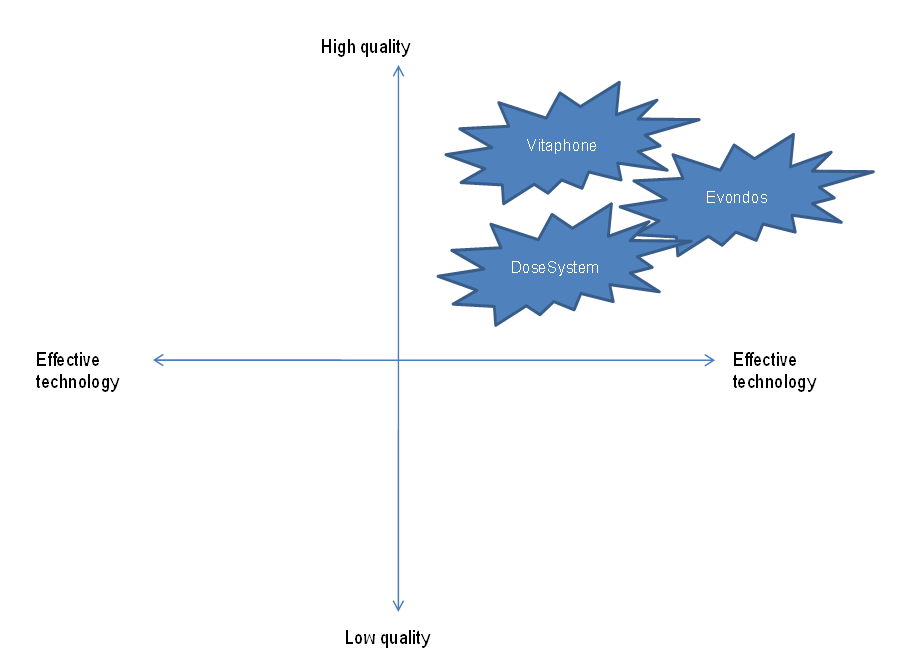
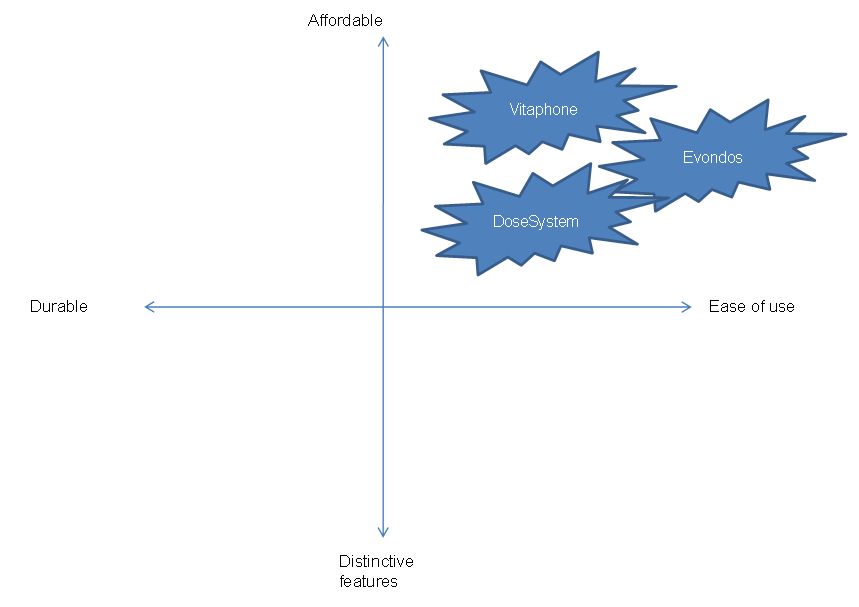
Porter’s Five Forces
The industry structure is another critical determinant in organisations’ internationalisation process. Thus, businesses need to evaluate the prevailing industry structure to make effective internationalisation decision. Porter’s five forces model can assist DoseSystem to understand the prevailing conditions in the US healthcare industry.
Rivalry – Strong
The US healthcare industry is characterised by a high degree of concentration, which has culminated in intense competition. Several large entities such as Humana, Amerigroup, Wellpoint Incorporation, Coventry Health Care, WellCare Health Plans, and Cigna dominate the industry. The industry players are increasingly leveraging on IT as a source of competitive advantage. The firms have developed a substantially strong financial base. Thus, they can invest in successful research and development, hence promoting their new product development process. Most industry players are investing in health IT products to promote their capacity to offer citizens quality health care. Moreover, the industry players are incorporating the concept of consolidation in their operations by acquiring small and medium-sized entities in the industry.
Threat of New Entrant – High
Despite the domination of the US healthcare industry by a few firms, the threat of entry remains considerably high. New entrants into the US healthcare industry are attracted by its profitability potential. The new entrants are devising strategies to draw revenue from traditional healthcare firms. The firms are implementing this strategy by incorporating the concept of new product innovation to deliver effective healthcare services to citizens.
Threat of Substitute – Low
The high profitability potential in the US healthcare industry has improved its attractiveness to potential investors. Different investors are considering venturing into the industry by offering different products. Twenty-six of the Fortune 50 companies entered the healthcare industry. The companies were from different sectors such as automobile and technology and telecommunications companies. These companies are increasingly considering improving the quality of care to patients suffering from chronic diseases by developing new and innovative products. However, the industry is not characterised by intense competition regarding medication solutions. This aspect means that there is a high probability of DoseSystem gaining adequate market acceptability.
Buyer Bargaining Power – Weak
The Buyer’s bargaining power refers to the consumer’s/buyers’ capacity to influence the businesses’ strategies such as pricing and product development. The healthcare providers can influence customers to purchase the decision for healthcare products through their price-setting capacity.
Supplier Bargaining Power – High
Healthcare product and service providers in the US specialise in offering the citizens’ unique products. Furthermore, the demand for healthcare services in the US has increased substantially over the past few years due to a change in the citizens’ lifestyles. For example, the US has experienced a considerable increase in the number of citizens suffering from chronic diseases. Subsequently, the demand for effective and efficient medication has grown remarkably. On the contrary, the number of suppliers offering medication solutions to citizens is considerably low. This aspect means that the suppliers of healthcare products and services have high bargaining power. Thus, they can set the price of their healthcare products at a point that can lead to profit maximisation.
Entry Mode
Countries intending to enter a foreign market must adopt effective modes of entry to achieve the desired strategic goals. In its quest to enter the US market, DoseSystem should consider different modes of entry. Some of the methods that the firm should consider are evaluated herein.
International Licensing
Lou (2002, p.200) defines international licensing as ‘an entry mode in which a foreign licensor grants specified intangible property right to the local licensee for a specified period in exchange for a royalty fee’. Some of the property rights that the firm should consider include patenting and trademarks. Under this agreement, the licensee will be charged with the responsibility of producing and marketing the DoseSystem in the host country. The concept of licensing will improve the firm’s ability to penetrate the US market.
International Franchising
DoseSystem’s designers should also consider integrating the concept of franchising. The franchising strategy will ensure that the brand is protected in the international market. Additionally, the strength of the brand will be maintained because the franchisees will be required to adhere to strict rules on how to handle the product.
Resources and Capabilities
To succeed in the international market, the organisation must possess sufficient and relevant resources and capabilities as evaluated herein.
Financial Capital
The organisation will be required to possess sufficient financial capital to undertake effective product introduction in the target market. The firm’s financial strength will also influence its capacity to manufacture sufficient DoseSystem that adequately meets the prevailing market demand.
Human Capital
The effective introduction of the product in the market will also depend on the skills and expertise of the firm’s human capital. The firm’s human resources should have an adequate market and product knowledge. These capabilities will influence the consumers’ ability to influence the target consumers.
SWOT Analysis
The chart below illustrates the strengths, weaknesses, opportunities, and threats associated with the introduction of the DoseSystem into the US.
Target Market Analysis
Target Customers
The organisation has targeted both individual and institutional customers to maximise profitability. Institutional customers include healthcare organisations. On the other hand, individual customers vary across diverse demographic characteristics such as age and income. The choice of this market segmentation strategy has been informed by the recognition of the fact that chronic diseases have become prevalent across individuals of different demographic characteristics. For example, diabetes has become a common problem for both young and aged citizens.
Industry Sales and Company Sales
The organisation intends to maximise its profitability. The firm intends to generate $1.5 million in sales revenue within the first year of introducing DoseSystem in the market. However, the firm projects that the sales revenue will grow by 15% annually. Consequently, the firm will be in a position to maximise its profitability.
Value Proposition
Valuable Capabilities
The DoseSystem will lead to an improvement in the citizens’ quality of life due to its capacity to remind them when to take their medication. Thus, it will promote their health well-being. Its capability will be enhanced by incorporating effective digital technologies.
Rare
The rare capability of DoseSystem arises from the view that it will be synchronised with different Internet-enabled hand-held devices such as smartphones and tablets. This aspect will improve make the medical solution device convenient to use.
Imitable
The new product will be difficult to imitate because of the designer’s core competence in product development. The designers will improve the DoseSystem continuously, hence making it difficult to imitate.
Customer Buying Habit and Preferences
Patients and healthcare providers in the US have become conscious of the importance of adhering to medication program. The behaviour change has emanated from the recognition of the risk associated with failure to adhere to the medication program. Past studies conducted in the US show that a considerable number of patients have died or suffered injuries due to ineffective medication such as failure to take the drugs as prescribed by the physicians.
Market Entry Strategy
In its initial market entry strategy, DoseSystem should adopt the direct exporting strategy (Jeyaseeli & Levi 2006). This aspect means that the production process should be undertaken in Denmark or other countries characterised by the low cost of production. Doole and Lowe (2008, p. 239) affirm that direct exporting enable businesses to minimise the cost of marketing in a foreign country.
Marketing Mix Strategies
Effective product introduction in the target market is essential in attaining market success. In a bid to achieve this goal, organisations need to adopt effective marketing mix strategies (Marek 2014, p.259). The firm’s management team should consider the following strategies.
Product Strategy
The product designers should ensure that the DoseSystem is designed effectively to create additional value for citizens in their medication process. Hitt, Ireland, and Hoskission (2013, p. 125) assert that consumers are increasingly being concerned with product quality. Therefore, product designers should invest in continuous product improvement, which should be based on the findings of market research. One of the issues that the designers should focus on in their product improvement process entails the effectiveness and ease of product use.
Distribution Strategy
Because the product is new in the market, DoseSystems should distribute the product using the selected agents. This move will ensure that the product is protected from counterfeiters. Additionally, the firm will ensure that the agents have adequate product knowledge, hence transferring it to the customers. Consequently, the firm will improve product usability.
Communication Strategy
Creating market awareness is an essential element in an organisation’s quest to introduce a new product in the market successfully. The communication strategy promotes the products’ value (McDonald, Smith & Ward 2007, p.17). In ab bid to influence consumers’ purchase decisions, DoseSystem must ensure that a substantially large number of citizens understand how the product works. During the market communication phase, DoseSystem needs to adopt integrated marketing communication. However, the firm should be committed to adapting its marketing communications strategy to the target market to improve the contribution of the strategy to the firm’s overall market performance (Naidoo & Terry 2011, p.1127).
In a bid to ensure that the strategy is adapted to the market needs, DoseSystem should study the market communication trends in the US. In its integrated marketing communications strategy, DoseSystem should adopt diverse marketing communication methods. Some of the common methods that should be considered include advertising and public relations.
In its advertising process, DoseSystem should integrate traditional and contemporary mediums of advertising such as print media, broadcast media, and social media. Conversely, the public relations method should be implemented by liaising with healthcare providers in the US such as hospitals. This form of the partnership will improve the effectiveness with which DoseSystem penetrates the US healthcare industry due to increased publicity.
Conclusion and Recommendations
The above analysis shows that the US healthcare industry is an attractive market destination for DoseSystem. Its attractiveness has arisen from the high demand for medication solutions to manage chronic diseases, which have become a major challenge in the US. Moreover, healthcare providers and individual patients are appreciating the role of technology in improving the patients’ welfare. However, to enter the US market successfully, DoseSystem must consider some issues, which include.
- The firm should improve the DoseSystem continuously by conducting extensive research and development, which will form the basis for product innovation.
- DoseSystem should evaluate the prevailing market trends continue to determine their impact on the new product introduction process.
Reference List
David, G & Boryana, D 2014, ‘Business and cultural aspect of psychic distance and complementarity of capabilities in export relationships’, Journal of International Marketing, vol. 22, no. 3, pp. 50-67.
DePhillips, H 2007, ‘Initiative and barriers to adopting health information technology’, Management Health Outcomes, vol. 15, no. 1, pp. 1-6.
Dirk, D & Zhou, L 2014, ‘Entrepreneurial strategic posture and performance in foreign markets; the critical role of international learning effort’, Journal of International Marketing, vol. 22, no. 2, pp. 47-67.
Doole, I & Lowe, R 2008, International marketing strategy; analysis, development and implementation, Cengage Learning, London.
DoseSystem: Peace of mind for caregivers 2015, Web.
Dragnic, D 2014, ‘Impact of internal and external factors on the performance of fast-growing small and medium businesses’, Management, vol. 19, no.1, pp. 119-159.
Evondos: Patient safety in medical treatment at homes improves significantly 2014, Web.
Gabrielsson, P, Gabrielsson, M, Seppala, T 2012, ‘Marketing strategies for foreign expansion of companies originating in small and open economies; the consequences of strategic fit and performance’, Journal of International Marketing, vol. 20, no. 2, pp. 25-48.
Gordon, R 2012, Is the US economic growth over? Faltering innovation confronts the six headwinds, Web.
Hitt, M, Ireland, D & Hoskission, R 2013, Strategic management; competitiveness and globalisation; concept and cases, South-Western Cengage, Mason.
Jeyaseeli, K & Levi, B 2006, Market entry strategies of foreign telecom companies in India, Wiesbaden, Fribourg.
Luo, Y 2002, Multinational enterprises in emerging markets, Copenhagen Business School Press, Copenhagen.
Marek, P 2014, ‘A critical analysis of the concept of marketing strategies for small and medium sized companies’, Economics, Management & Financial Markets, vol. 9, no. 4, pp. 255-261.
McDonald, M, Smith, B & Ward, K 2007, Marketing due diligence; reconnecting strategy to share price, Butterworth-Heinemann, Boston.
Morgan, S & Kennedy, J 2010, ‘Prescription drugs accessibility and affordability in the United States and abroad’, Issues in International Health Policy, vol. 89, pp. 1-11.
Naidoo, V & Terry, W 2011, ‘Marketing strategy implementation in higher education; a mixed approach for model development and testing’, Journal of Marketing Management, vol. 27, no.11, pp. 1117-1141.
Ramaseshan, B, Ishak, A & Russell, K 2013, ‘Interactive effects of marketing strategy for formulation and implementation upon firm performance’, Journal of Marketing Management, vol. 29, no. 11, pp. 224-1250.
Redwood, S, Rajakumar, A, Hodson, J & Coleman, J 2011, ‘Does the implementation of an electronic prescribing system create unintended medication errors? A study of the sociotechnical context through the analysis of reported medical incidents’, BMC Medical Informatics & Decision Making, vol. 11, no. 29, pp. 82-96.
Trading Economics: United States inflation rate, 2015, Web.
United States Department of Commerce: Regulatory compliance costs 2015, Web.
United States Department of Commerce: political and security risks; US 2015, Web.
Vision For Healthier Future: The growing crisis of chronic disease in United States 2007, Web.
Vitaphone: Innovative telemedicine care management 2015, Web.